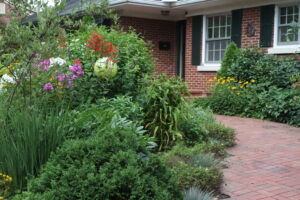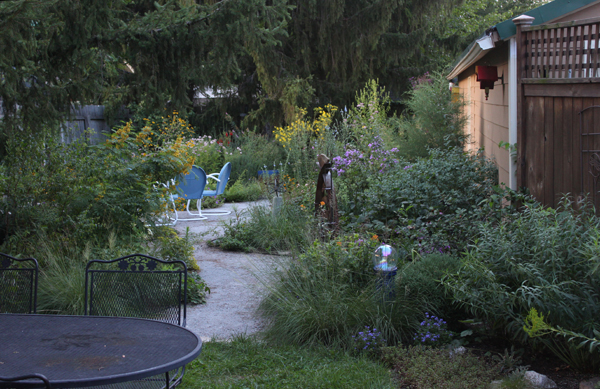All gardens, even the most formal, take their inspiration from Nature. Plants, which are living and growing organisms, give them their form and meaning. For native plant gardeners this connection with Nature is a far more serious matter than for others. They take pride in the fact that their garden belongs to a specific place on the planet earth. They acknowledge the existence of eco-regions, based on climate, topography and soil, and they think of their garden as an integral part of its region. They also recognize that a garden is not just about the plants that grow there – it is also about the wildlife it sustains.

But a garden is not a meadow, or a prairie, or a wetland, or a glade, or a forest. It consists of an arrangement of plants growing in soil that was once disturbed through human activity, and often quite recently so. It usually surrounds a dwelling. There are probably hard surfaces on the property: a driveway, paved walkways, one or several patios, platforms to house a/c units and trash cans. And all gardens have boundaries: visible fences or invisible lines running between survey markers.

Gardeners who are strongly committed to Nature may choose to ignore the limits they face in the form of walls and hardscapes. They may simply plant where they find available ground. But that does not usually result in a good garden. The challenge is to let the human-made features of a property guide the placement of desired plants. A paved garden walk can be framed by perennial flowers, grasses, shrubs, or a combination of all three; the height of the frame should relate to the width of the path. A front patio near the entrance door should receive special attention; perhaps it can be a bit more formal than the rest of the garden. Driveways are the stepchildren of landscape designers, who tend to leave turf grass on both sides for the convenience of stepping into and out of cars. But shrubs can be judiciously placed where no one ever needs to step. An a/c unit in need of disguise can be hidden by many different kinds of plantings; the trick is to make the planting look as if it belongs there.
Design ideas that use the limits posed by human habitation creatively make the garden sing. They convey a sense that the plants belong not only to their ecological realm – they also belong to a place in which humans invest their care, creativity and hope.
Native plant gardeners are fortunate in being able to work with a wide range of plants. Their plants don’t need to be showy (though many are) or evergreen. Their plantings usually follow Nature through the seasons providing ever new sights and experiences. Spring ephemerals signal the end of winter; in May migrating birds sing from oak trees attracted there by the abundance of caterpillars feeding on their young leaves; throughout the summer the garden hums with bees, wasps, bugs and beetles, all attracted to the many flowers in bloom; and the colors of fall asters followed by the changing leaves of shrubs and trees amount to an annual miracle.

There is always more than one possibility for arranging plants in a garden to produce this repeated spectacle. While better and not so good ways exist for using plants to enhance a property with its dwelling, boundaries and hardscapes, there is never a perfect way. Nobody would categorically say: “this walkway needs to have a border of Pennsylvania sedge”, or: “this patio should be surrounded by a succession of meadow phlox, purple coneflowers and New England asters.” There are dozens of options for each scenario, and happy gardeners learn to experiment and to be playful about making choices. There are as many gardens as there are gardeners, and perhaps it is this variety that makes visiting gardens so enjoyable. Visitors to well-loved gardens expect surprise, beauty and pleasure: a plant paired with an ornament in an imaginative way; a grouping of several familiar plants each of which enhances the others; a creative idea to both mark and disguise the property’s boundary with plants.
For a number of years our Wild Ones chapter scheduled an annual garden tour. It was fun for our visitors, but it was also a lot of work for the garden hosts and the organizing team, and we ran out of energy for the program. This year we are trying something new. We are offering our Members and Friends the opportunity to visit several private gardens through the spring and summer. Seven courageous owners are opening their gardens for two or three hours, each on a different Saturday morning. Some are native plant purists; others prefer a mixture of natives and non-natives. One exuberant garden focuses on vegetables. Most are well established. The idea is to convey an impression of the variety of natural gardens in Lexington. We hope that these visits will be inspirational, instructive, and – above all – enjoyable.
Beate Popkin
